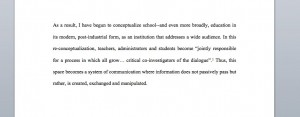A lot of my work at School One thus far has led me to consider individual practices and specific activities that students undertake in digitally-driven classrooms. I have not, however, really reflected on the concept of “school” as a whole. I realised this in a process of reflection, whereupon I dug up this snippet from my original independent major proposal:
In seeing this, I found a way to rethink Friere’s idea of pedagogy into my work at School One. Friere suggests a method of learning/teaching/growing that positions the individual as the cultivator of her own growth. She interacts with her environment, both physically and virtually, to create her own empowering language that feeds into how she thinks, understands, is. I have considered this as self-motivated learning, but with a component that requires an active remaking and rethinking on the part of the student. However, I can’t help but consider how a digital environment feeds this type of learning. While Henry Jenkins (in Convergence Cultures: Where Old and New Media Collide) speaks to the possibility of discovering new worlds and avenues for learning, how do we encourage students to participate in this generative environment/way of learning?
This question does not only implicate the student; teachers, administrators, and parents play a role in the production of this dialogue as well. To increase the dialogue between all these participants will ultimately equip all participants with their own individualized processes of making meaning in their worlds. But what is the role of digital technology in this?
My initial reaction suggests that digital multimedia provides room for deeper, more intense conversations to occur. Further, given the multiple modes accessed through the interface of the screen, I hypothesize that digital technology also provides the space for conversation/learning to occur outside the boundaries of language. (See this project where I wrote on how alternate modes of presenting information brings greater depth to understanding/learning) But other than email/Google Docs, I struggle to see exactly how digital tools are impacting the communication surrounding student learning. Perhaps this comes with time?
